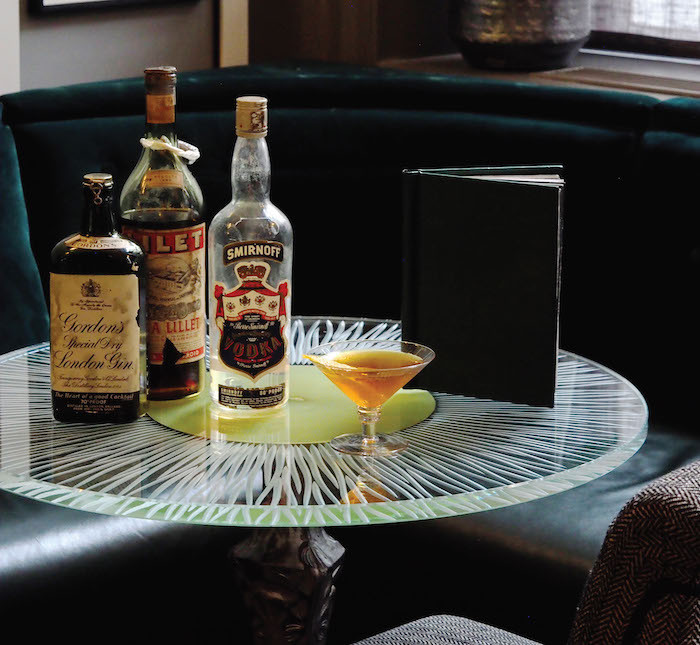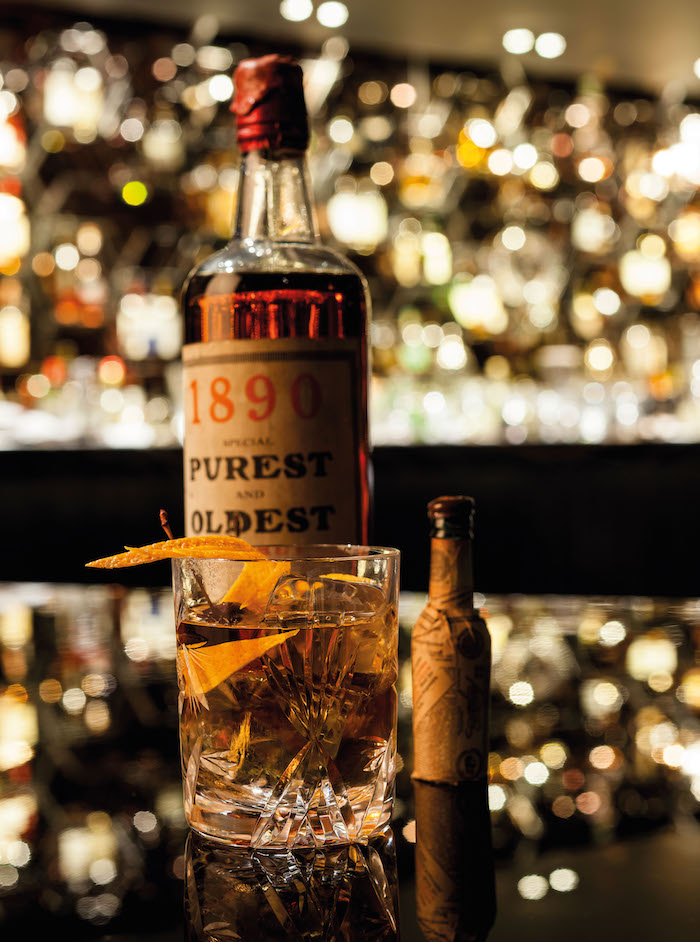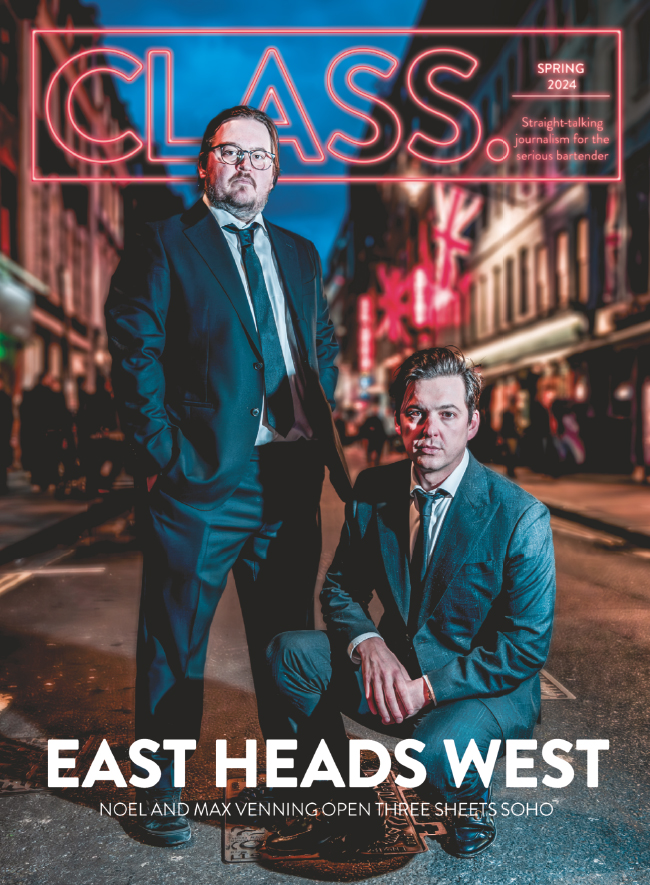
Salvatore Calabrese has amassed a treasure trove of vintage spirits. Hamish Smith tries some of his ancient collection in cocktails tasted against their latter-day equivalents.
The Walkure sank in 1911, a year before the Titanic. She ran aground on the Haisborough sands off north east Norfolk, on route from Hamburg in Germany to Santos in Brazil. Her cargo was significant: £40,000 of sewing machines, disinfectant, spun yarn, margarine, steam machinery, bath tubs, bicycles and crockery among it. And a “large quantity” of spirits.
What the tugboats couldn’t salvage lay submerged for the best part of a century. Still is, except for a few items recovered by hobbyist shipwreck divers in 2002. Among the salvaged bounty, bottles of Hollands gin – genever – from Wynand Fockink distillery of Amsterdam, a 17th century company still in operation today.
By dint of a chance meeting between Salvatore Calabrese and these very divers, one of their bottles sits before me right now. The case that housed the bottles might have helped, the cork too slowed ingress, because despite 91 years breathing in the North Sea, the genever is remarkably intact.
This is what Calabrese calls liquid history. Bottles with yarns longer than your arms and each of them available – if you’re rich enough or lucky enough – through Donovan Bar’s Vintage Spirits & Cocktails menu. For the curious, cocktails start at £300 and rise up into the thousands. So you can guess which category of customer I fall into.
But I’m not here at Donovan Bar to pronounce on whether these vintage cocktails are worth their price tags. Rarity distorts price, and besides, value for money is in the wallet of the beholder. No, I’m interested in what these spirits taste like. Whether time (or even sea water) imbues the spirit with some indefinable quality. Whether spirits making was different 100 years ago, and if mingled in with similarly aged liquids – vermouths, liqueurs – you can taste the history in the glass. And I want to compare them to their modern-day equivalent as best we can, without needing to say which is better, nor being too fussy about the comparison parameters, taking the joy out of the experience.
The bartenders for the day are Federico Pavan and the man himself, Salvatore Calabrese. They start with the shipwrecked Fockink. In the tasting glass it has a rush of salinity and seaweed – the mind taking you straight to nori, to umami notes and oyster sauce. But it’s not a hostile takeover. There’s a lot of 1900s genever in there too, punching through the salty wash. In the Martinez, it’s sharing the glass with Zara Maraschino and Angostura Bitters from the 1930s and a Martini Rosso from 1970s, which together shade some of the briney notes, marrying together beautifully.
The contemporary Martinez uses Old Duff (the closest match available), and is rounder, more polished, the liqueurs and vermouth seemingly sweeter today. If I were having just one, I’d have the vintage Martinez. Any more, its younger incarnation. I never thought I’d have an opinion on antique shipwrecked spirits, but they’re best enjoyed in moderation.
Next came the Dry Martini. Here Calabrese has Park & Tilford London Dry gin which was produced in the UK for the US market and dated from 1900. It was compared with a Tanqueray Dry Martini – and for the record, both used a modern vermouth (Mancino Secco) so as to not sacrifice Calabrese’s very last Noilly Prat from 1890. The antique gin had flint and grassy notes and, while the abv would have retreated over the years, it still had a concentrated profile compared to its modern equivalent. Less refined, maybe, but more characterful for sure.

Fragile spirit
Right, Daiquiri time. For this Calabrese uses a 1905 Bacardi Superior, which has a strawish hue with no signs of colour filtration. In the mouth it’s mellow but lacks teeth, either the style of the period or time having eroded its power. Calabrese adjusts the spec for this fragile spirit and shakes softly so to not overpower it, but the result isn’t as vibrant as its modern-day equivalent.
But where the antique rum was outmuscled by the citrus, the cognac in the vintage Sidecar wasn’t. “This most exemplifies liquid history – drinking this, you could be in Harry’s Bar,” says Calabrese. “This is one of the first cognacs after phylloxera – there was a long time when they couldn’t make cognac.”
That cognac was Adet Grande Champagne from the 1930s – with Cointreau from the same decade – and it the most vibrant vintage spirit of the tasting. The cognac is huge, and makes one of the most delicious, balanced Sidecars I’ve ever tasted. Perhaps, even, making sense of the often derided specs for this recipe, devised as they were in the early 20th century.
So to the Vesper. “This is the most hunted bottle in the world of bartending,” says Calabrese. He’s referring not to the mid-century gin and vodka in front of me, but the Kina Lillet, of which he says he has one of the world’s largest collections. This edition is from 1967 – all within a decade or so of Fleming inventing the Vesper in the creation of James Bond. Not coincidently, Calabrese first had the idea for his liquid history serves while working at Duke’s, Fleming’s most frequented bar. “When I came up with the idea in the 1980s, people thought I was crazy – it didn’t resonate,” says Calabrese. Side by side, the two Vespers are similar – the white spirits remarkably timeless in flavour and condition. But if you split them, the vintage Vesper has a quinine layer thanks to the inclusion of Kina Lillet, for which there isn’t a modern equivalent.
We finish with the Old Fashioned and the oldest spirit in the tasting – a bottle of Purest and Oldest American whiskey from 1890, bottled in 1906. On the palate, it’s what you’d expect from a 16-year old bourbon, with perhaps a little bit of oxidative maturation. It made for a concentrated, layered Old Fashioned. It is, of course, vulgar to ask how much things are, but... “That bottle would be about £20k,” replies Calabrese “– what you’ve got in your tasting glass is about £1k worth.”
It wasn’t there long – 130 years in bottle and about 1 minute, 30 seconds in glass. But fleeting moments are sometimes the most memorable. Whether these vintage cocktails are better or worse, I couldn't say, but they are a window to a world, a seat at the bar of a bygone era and that’s really something – to me anyway. As Calabrese says, with one of his impeccable, tailored one-liners: “You’ve just tasted 1,000 years of history.” And probably for the last time too. Unless of course, I do what Calabrese did – I’d need to start collecting now.

